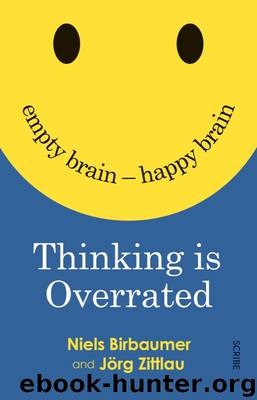Thinking is Overrated: empty brain -- happy brain by Niels Birbaumer & Jorg Zittlau (Translated by David Shaw)

Author:Niels Birbaumer & Jorg Zittlau (Translated by David Shaw) [Birbaumer, Niels & Zittlau, Jorg]
Language: eng
Format: epub
Tags: SCI089000, SEL031000, SEL024000, SEL016000, PHI025000
Publisher: Scribe Publications
Published: 2018-01-02T00:00:00+00:00
7
Training for Emptiness
why is a mouse when it spins
We have ascertained that certain conditions must be met for us to achieve a pleasant experience of emptiness. The brain needs to create certain wave patterns, and the body’s defence system must be at rest. The flood of signals from our sensory-perception system needs to be at a very low ebb, and, in particular, proprioceptive self-perception should be at peace. All this is impossible to achieve without a positive, unfearful attitude to emptiness, and trust in the process that leads us to it. But which of such processes can we trust?
We have already considered some of them. Philosophy can help establish the necessary basic outlook and offer a little understanding of what emptiness really means.
Floatation tanks can provide a way to unshackle ourselves from the flood of stimuli from our sensory systems. Modern tanks no longer resemble dark coffins, instead reminding us more of nuts, which represent the origins of life. In California, they are about as common as sunbeds are in darker climes, and some people even have their own tank installed at home in their living room or bedroom. The ideal length of a floating session is between an hour and an-hour-and-a-half — easily included in a normal weekly routine, since it doesn’t have to be done every day.
Appropriate relaxation techniques such as autogenic training or progressive muscle relaxation as developed by Edmund Jacobson are certainly helpful in achieving emptiness. They are proven to reduce muscle tension and therefore reduce the deluge of stimuli from the proprioceptive senses. Their effect in this respect is not as violent as that of curare, but, on the other hand, they do not require the use of a ventilation machine. However, these methods can only achieve the ‘emptiness effect’ if practitioners become skilled enough in them to progress beyond the stage of just practising. Anyone who is occupied with chanting ‘my belly is full of warm bread rolls’ or ‘my pulse rate is pleasantly relaxed, powerful, and regular’ still has a long way to go before achieving emptiness.
Another approach would be to target not the body’s proprioceptors, but the part of the brain their signals are sent to for analysis and interpretation — the insula. That is a practicable alternative, as we have been able to show in Tübingen. The insula is able to learn, and one of the things it can learn is to ignore proprioceptive signals, at least to a certain extent.
Away from the island: how to find inner peace
The insula is buried below the temporal lobes and other parts of the brain, and so it was not discovered until the late 18th century. Naturally, its evolutionary history goes much farther back than that. This is reflected in the development of foetuses in the womb: while other ‘lobes’ of the brain, such as the cerebral cortex, continue to grow as a foetus develops, the insular cortex stops growing when it reaches about an inch across. But in terms of the wide range of functions it performs, the insula is a giant.
Download
This site does not store any files on its server. We only index and link to content provided by other sites. Please contact the content providers to delete copyright contents if any and email us, we'll remove relevant links or contents immediately.
The Way of Zen by Alan W. Watts(6505)
Ego Is the Enemy by Ryan Holiday(5294)
The Art of Happiness by The Dalai Lama(4063)
The Book of Joy by Dalai Lama(3899)
Why Buddhism is True by Robert Wright(3404)
Spark Joy by Marie Kondo(3249)
Shift into Freedom by Loch Kelly(3134)
Happiness by Matthieu Ricard(2992)
A Monk's Guide to a Clean House and Mind by Shoukei Matsumoto(2868)
The Lost Art of Good Conversation by Sakyong Mipham(2576)
The Meaning of the Library by unknow(2505)
The Unfettered Mind: Writings from a Zen Master to a Master Swordsman by Takuan Soho(2249)
The Third Eye by T. Lobsang Rampa(2225)
Anthology by T J(2161)
Red Shambhala by Andrei Znamenski(2148)
The Diamond Cutter by Geshe Michael Roach(2018)
Thoughts Without A Thinker: Psychotherapy from a Buddhist Perspective by Epstein Mark(1961)
Twilight of Idols and Anti-Christ by Friedrich Nietzsche(1849)
Advice Not Given by Mark Epstein(1839)
